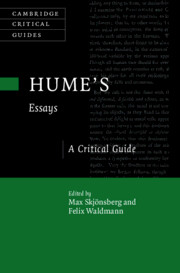Book contents
- Hume’s Essays
- Cambridge Critical Guides
- Hume’s Essays
- Copyright page
- Dedication
- Contents
- Figures
- Contributors
- Acknowledgements
- Abbreviations
- Introduction
- Part I Reception
- Part II Philosophy
- Chapter 4 Hume’s Essays as Philosophy
- Chapter 5 ‘The Sentiments of Sects’
- Chapter 6 Aesthetics and the Arts in Hume’s Essays
- Chapter 7 Religion, Anticlericalism and the Worldly Paths to Happiness in Hume’s Essays
- Part III Politics
- Part IV Political Economy
- Bibliography
- Index
- Cambridge Critical Guides
Chapter 5 - ‘The Sentiments of Sects’
Epicurean, Stoic, Platonist, Sceptic
from Part II - Philosophy
Published online by Cambridge University Press: 02 January 2025
- Hume’s Essays
- Cambridge Critical Guides
- Hume’s Essays
- Copyright page
- Dedication
- Contents
- Figures
- Contributors
- Acknowledgements
- Abbreviations
- Introduction
- Part I Reception
- Part II Philosophy
- Chapter 4 Hume’s Essays as Philosophy
- Chapter 5 ‘The Sentiments of Sects’
- Chapter 6 Aesthetics and the Arts in Hume’s Essays
- Chapter 7 Religion, Anticlericalism and the Worldly Paths to Happiness in Hume’s Essays
- Part III Politics
- Part IV Political Economy
- Bibliography
- Index
- Cambridge Critical Guides
Summary
Hume’s ‘four essays on happiness’ are distinctive in Hume’s oeuvre, and not merely in the 1741 volume of Essays, Moral and Political in which they appeared. They are written in the style of philosophical monologues, with Hume ‘personating’ a representative of each of the main, late Hellenistic philosophical sects in turn. Each such representative, however, engages critically with the philosophical positions staked out by his rivals and antagonists. The ultimate question each of the philosophical sects seeks to answer is: what is the true end (summum bonum) of human life, and where is true contentment to be found? Scholars have tended to be preoccupied with the question of which sect best articulates Hume’s own underlying philosophical commitments. This chapter argues that such an approach is mistaken, because Hume dismissed the quest for the summum bonum altogether. Hume presented all the late Hellenistic philosophical sects as capturing something important about human life, and about the purpose of philosophical activity. Yet ancient moral philosophers had ultimately failed to develop the ‘science of man’ that Hume took to be the greatest achievement of modern philosophy. The four essays, then, reveal Hume’s keen – and lifelong – interest in the history of moral philosophy, and his attentiveness to the distinctive (and superior) character of modern approaches to the discipline.
Keywords
- Type
- Chapter
- Information
- Hume's EssaysA Critical Guide, pp. 92 - 107Publisher: Cambridge University PressPrint publication year: 2025

